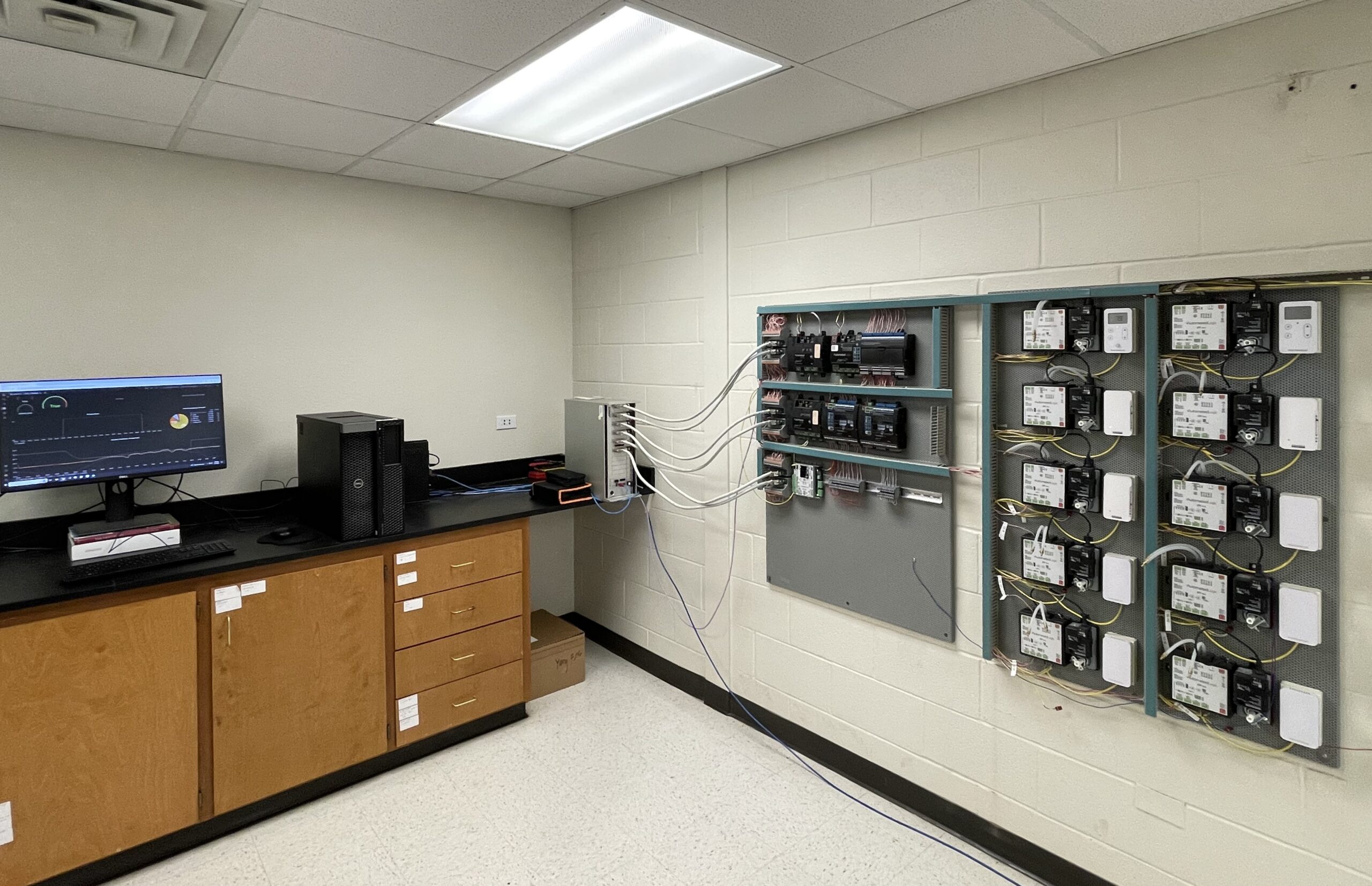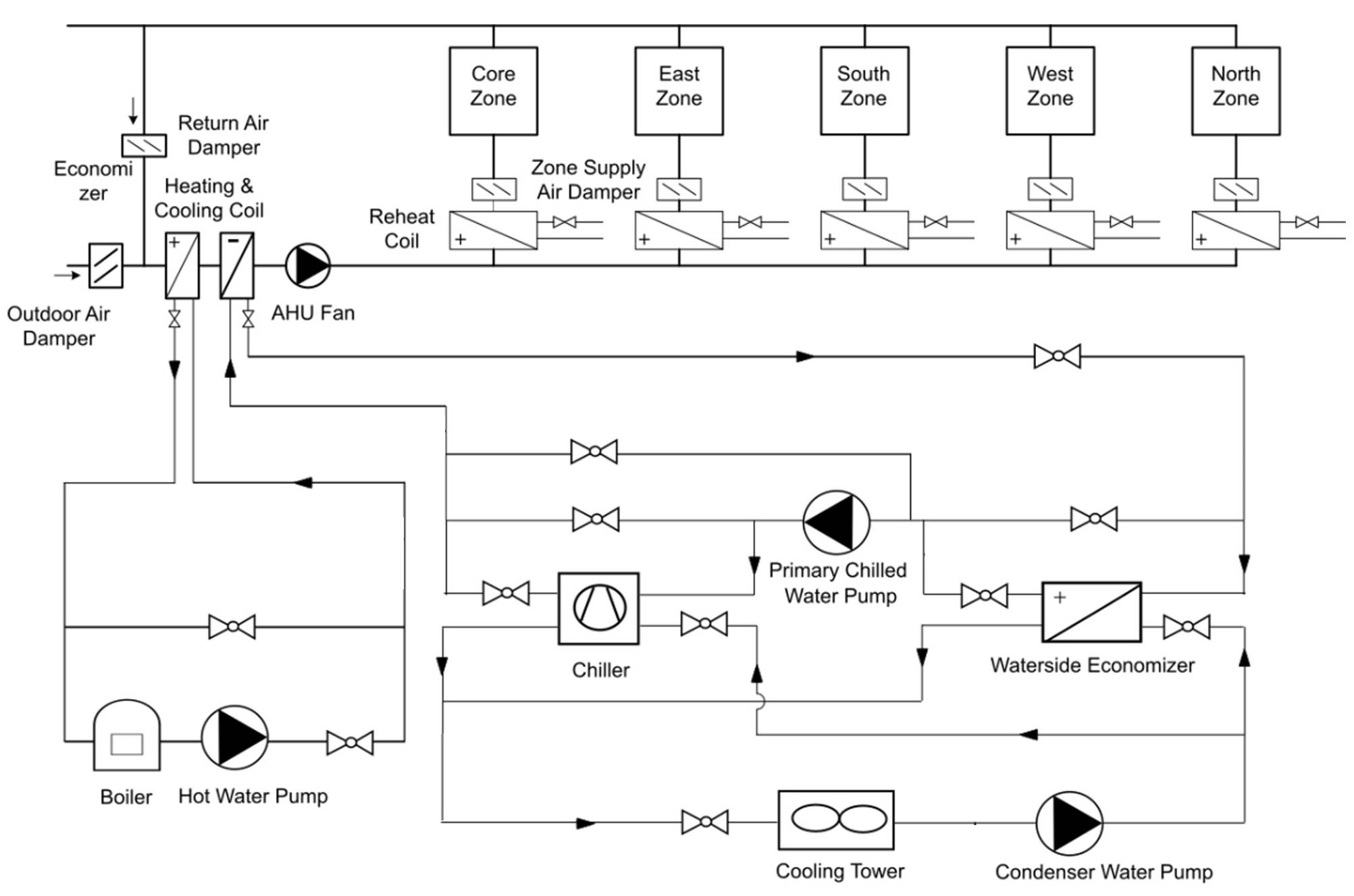Texas A&M Intelligent Building Automation System (BAS) Hardware-In-the-Loop (HIL) Testbed is developed for sensor and control-oriented studies on smart buildings. The testbed consists of three major components: a real-time dSPACE HIL machine, a set of Automated Logic Company (ALC) BAS controllers, and a computer server for the BAS system. The real-time HIL machine emulates a virtual building and associated HVAC system modeled in Modelica. The BAS controllers provide rule-based control logic for different HVAC equipment, and their control commands are sent to the virtual building through the real-time HIL machine. The computer server hosts the software environment for all the hardware and customized services such as a master program that controls the experiments. The computer server also acts as a remote access point to the BAS system providing monitoring and trending of operation data as well as supervisory control.


Configuration
| Item | Manufacturer | Configuration |
| DS6221 | dSPACE. Inc | Multi-channel A/D board with 16-A/D input channels, 16 independent A/D converters, 8 external trigger channels |
| DS6241 | dSPACE. Inc | Multi-channel D/A board with 20 D/A channels with independent converters and dedicated ground sense line per channel |
| DS6101 | dSPACE. Inc | 10 ADC, 12 digital inputs, 10 variable inputs (analog/digital), 8 DAC (DC), 4 DAC (DC) additional with current sink functionality, 3 DAC (AC), 14 digital outputs, 6 resistance simulation, 1 pair of direct coupled I/O channels |
| Computer server | Dell | Dell Precision T7920, Intel Xeon Gold 6230 |
| ACE 6001MC | dSPACE. Inc | Advanced control kit SCALEXIO 6001 consisting of DS6001 SCALEXIO processor board with Intel Core i7-6820EQ quad-core processor. |
| BAS controllers | ALC | VAV box controller, ZN341A (3 binary outputs, 4 universal inputs and 1 analog output) |
| ALC | AHU controller, OFBBC (supports up to 9 expanders, 180 I/O channels total) | |
| ALC | Chiller/boiler plant controller, OF1628-NR (supports up to 9 expanders, 224 I/O channels total) |
Summary of major software in the HIL testbed
| Item | Manufacturer | Configuration |
| ConfigurationDeskTM | dSPACE. Inc | Software kits to configure behavior model |
| ControlDeskTM | dSPACE. Inc | Software kit to control and visualize real-time experiment |
| Dymola/Modelica | Dassault | Software tool to model dynamic building energy system |
| WebCTRLTM | ALC | Building automation system server |
| EIKON-LogicTM | ALC | Software to configure controller logic for ALC equipment controllers |
| Python | n/a | Open-source programming environment to provide customized WebCTRL API and supervisory control |
| Wireshark | n/a | Open-source network packet analyzer |
Data Flow

Building and HAVC System
Heating and cooling are delivered by a single-duct VAV system. One AHU connected with five VAV terminal boxes serves five zones (four perimeter zones and one interior zone) on one floor. The chilled water is supplied by a central chiller plant that consists of a chiller, a waterside economizer, a cooling tower, a chilled water pump, and a cooling water pump. A boiler, fed by natural gas, supplies the hot water to the AHU heating coils. The VAV boxes are used to control the temperature of a corresponding zone with a centralized chiller and a boiler providing cooling/heating energy to zones. The supply air is conditioned by the heating/cooling equipment (e.g., coils) within the AHU. The VAV box adjusts this supply air, both in volume and temperature, to serve the desired zone to maintain the design zone air temperature setpoint and meet the required ventilation rate. The VAV box studied in this study accomplishes this by using both an airflow damper and a reheat coil valve. The damper closes or opens the airflow pathway to modulate the volumetric flow rate of the supply air into the zone. The reheat coil is a heating coil inside the VAV box, and its waterside valve can be regulated to reheat the supply air if needed.

Publications
Journal Papers:
- Li, Guowen, Lingyu Ren, Ojas Pradhan, Zheng O’Neill, Jin Wen, Zhiyao Yang, Yangyang Fu, et al. “Emulation and detection of physical faults and cyber-attacks on building energy systems through real-time hardware-in-the-loop experiments.” Energy and Buildings (2024): 114596.
- Li, Guowen, Zhiyao Yang, Yangyang Fu, Zheng O’Neill, Lingyu Ren, Ojas Pradhan, and Jin Wen. “A Hardware-in-the-loop (HIL) testbed for cyber-physical energy systems in smart commercial buildings.” Science and Technology for the Built Environment (2024): 1-18.
- Li, Guowen, Lingyu Ren, Yangyang Fu, Zhiyao Yang, Veronica Adetola, Jin Wen, Qi Zhu, Teresa Wu, K. Selcuk Candan, and Zheng O’Neill. “A critical review of cyber-physical security for building automation systems.” Annual Reviews in Control (2023).
- Fu, Yangyang, Zheng O’Neill, Zhiyao Yang, Veronica Adetola, Jin Wen, Lingyu Ren, Tim Wagner, Qi Zhu, and Terresa Wu. “Modeling and evaluation of cyber-attacks on grid-interactive efficient buildings.” Applied Energy 303 (2021): 117639.
- Fu, Yangyang, Zheng O’Neill, and Veronica Adetola. “A flexible and generic functional mock-up unit based threat injection framework for grid-interactive efficient buildings: A case study in Modelica.” Energy and Buildings 250 (2021): 111263.
Conference Papers:
- Li, Guowen, Zheng O’Neill, Jin Wen, Ojas Pradhan, Lingyu Ren, Teresa Wu, Veronica Adetola, K. Selcuk Candan, and Qi Zhu. “CYDRES: CYber Defense and REsilient System for securing grid-interactive efficient buildings.” In Proceedings of the 10th ACM International Conference on Systems for Energy-Efficient Buildings, Cities, and Transportation, pp. 307-309. 2023.
- Li, Guowen, Zhiyao Yang, Yangyang Fu, Lingyu Ren, Zheng O’Neill, and Chirag Parikh. “Development of A Hardware-In-the-Loop (HIL) Testbed for Cyber-Physical Security in Smart Buildings”, 2023 ASHRAE Winter Conference in Atlanta, GA, Feb 4-8, 2023.
- Chu, Mengyuan, Yangyang Fu, Zheng O’Neill. “Maximum-Impact Adversary Design for Network-Based Control System: Case Study on Grid-Interactive Efficient Buildings”, 2023 ASHRAE Winter Conference in Atlanta, GA, Feb 4-8, 2023.
Contact
- Dr. Zheng O’Neill, PhD, PE
J. Mike Walker ’66 Associate Professor
J. Mike Walker ’66 Department of Mechanical Engineering
Texas A&M University
Mechanical Engineering Office Building (MEOB) 326
College Station, TX, 77843
Ph: 979-845-4931 | Email: ZOneill@tamu.edu
- Guowen Li
Graduate Research Assistant
J. Mike Walker ’66 Department of Mechanical Engineering
Texas A&M University
College Station, TX, 77843
Email: guowenli@tamu.edu
- Dr. Zhiyao Yang, PhD
Senior Research Engineer I
J. Mike Walker ’66 Department of Mechanical Engineering
Texas A&M University
College Station, TX, 77843
Email: z.yang@tamu.edu
Sponsor

